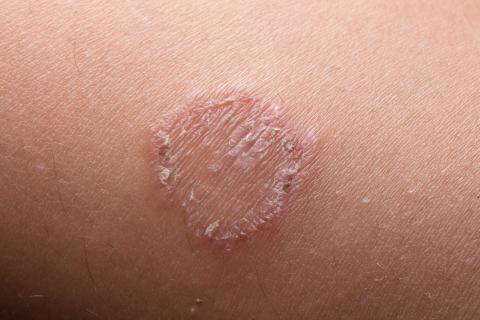Ringworm
Ringworm is a common fungal infection that can cause infection on the skin, nails, and other areas. The infection is called ringworm because it usually causes a red, itchy rash shaped like a ring.
Ringworm can be on different places of the body, including the feet, scalp, groin, fingernails, and toenails. Ringworm is sometimes named for where it is on the body, such as athlete's foot when the infection is on the feet.
Anyone can get ringworm. Children are more likely to get certain types of the ringworm fungi, but other types cause infection equally among all age groups.
Ringworm 101
Ringworm is spread through skin-to-skin contact with infected humans or animals, or contact with an item an infected person has touched.
- People can get ringworm by touching the rash on infected humans, pets, and livestock. People who have close contact with animals may be more likely to get ringworm.
- Ringworm can also be spread by touching objects used by an infected person, such as hair brushes, barber clippers, clothing, towels, shower stalls, and benches.
- People who use public showers or locker rooms are at greater risk of getting ringworm.
- Those who participate in contact sports, such as wrestling or football, are more likely to get ringworm.
Signs and symptoms usually show up about four to 14 days after contact with ringworm fungi.
The symptoms of ringworm depend on the location of the infection on the body.
General signs and symptoms:
- Itchy skin
- Flat, ring-shaped rash that may be dry and scaly or moist and crusted.
- The rash is usually red and itchy.
- As the rash grows, the skin in the center often clears.
- Temporary hair loss where the rash is present.
Ringworm on the feet (athlete's foot): Athlete's foot involves red, swollen, peeling, itchy skin, often between toes, and sometimes on the sole and heel of the foot. It can cause blisters on the feet in severe cases.
Ringworm on the scalp: This usually starts with a small pimple that grows over time, causing a scaly, itchy, red, circular bald spot on the scalp. The bald spot can grow in size and number as the infection spreads. Ringworm on the scalp is more common in children than adults.
Ringworm on the groin (jock itch): Jock itch involves scaly, itchy, red spots in the groin area.
Ringworm on the beard: This causes scaly, itchy, red spots on the cheeks, chin, and upper neck. The spots might become crusted over or filled with pus, and hair loss may occur.
Ringworm on the fingernails and toenails: Nails become thick and break easily. They may become white, yellow, or brown.
The treatment for ringworm depends on where it is on the body and the severity of the infection. Some forms can be treated with over-the-counter antifungal medications, but others must be treated with prescription antifungal medication.
Ringworm on the skin can usually be treated in two to four weeks with nonprescription antifungal creams, lotions, or powders. Ringworm on the scalp usually needs to be treated with prescription antifungal medication taken by mouth for one to three months.
Contact your doctor if your infection on the skin gets worse or doesn't go away after using nonprescription medications, or if you have ringworm on the scalp.
To prevent getting ringworm, or prevent spreading it to others:
- Keep skin clean and dry.
- Don't walk barefoot in locker rooms or public showers.
- Clip fingernails and toenails short and keep them clean.
- Wear breathable shoes.
- Change socks and underwear at least once a day.
- Don't share clothing, towels, sheets, or personal items with someone who has ringworm.
- Wash hands properly after playing with pets. Take your pet to the veterinarian if you think it may have ringworm.
- Shower after practice or games if you are involved in contact sports.
- Keep sporting gear and uniforms clean.
- Don't share equipment with other players.
- Ringworm fact sheet, P-42085 (Multiple Languages): The Department of Health Services (DHS) fact sheet with information on ringworm signs and symptoms, diagnosis, treatment and more.
- Wash Your Hands!, P-01710: DHS flyer with information on proper handwashing techniques.
- Ringworm: The Centers for Disease Control and Prevention (CDC) page with information on prevention, diagnosis, treatment and more.
Questions about ringworm? Contact us.
Phone: 608-267-9003 | Fax: 608-261-4976


